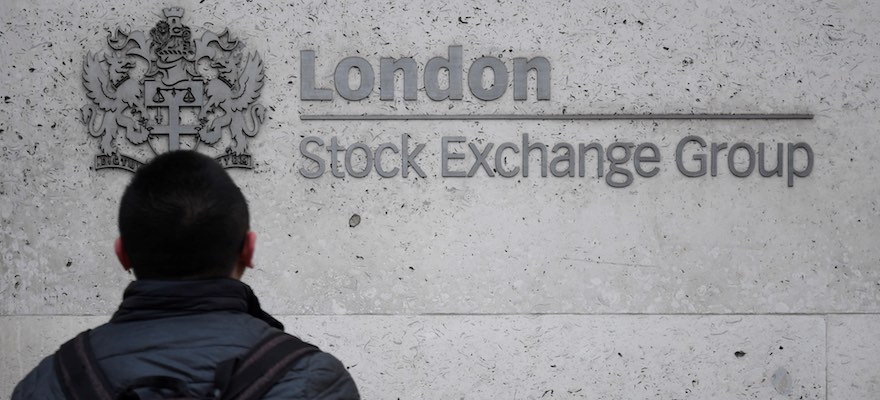Pacific Investment Management Co. says China’s inclusion in major global bond measures within two years will usher in an era where the nation’s financial markets are more relevant to global investors than its factories.
Luke Spajic, a Singapore-based money manager at Pimco, sees next year or 2018 as a realistic target for index compilers to add the world’s third-biggest bond market to their gauges. Still, that’ll only happen if policy makers can make progress before year-end on addressing investor concerns about settlement and currency conversion, Spajic said in an interview on Monday.
“We are moving from Made in China to Trade in China,” he said. “A foreign investor has a pretty long checklist before entering a market, and the bottom line is - knowing fully how easy is to go into an investment, how easy is to get out of an investment."
Investors and index compilers are awaiting details on China’s commitment last month to further open its giant interbank bond market, a major step in improving international access. JPMorgan Chase & Co. said last week it will review whether to give China a 10 percent weight in its widely tracked emerging-market debt index, as Citigroup Index LLC monitors developments. A 5-8 percent weighting in Citigroup’s global gauge would spur passive inflows of as much as $160 billion, Standard Chartered Plc estimates.
Currently, international investors are making the opposite trade, with their holdings of onshore bonds declining for a third month in February amid concern about a weaker and more volatile yuan.
“For foreign investors, it may not necessarily be as attractive right now, given the currency hedging costs,” Spajic said. “The challenge remains for the balance of the year to see how locals react to the new economic conditions.”
China has accelerated the opening of its financial markets before the International Monetary Fund adds the yuan to its reserve currency basket later this year. Developing robust capital markets is a way to address the nation’s high leverage, People’s Bank of China Governor Zhou Xiaochuan said at a forum in Beijing on the weekend. MSCI Inc. is due to reassess whether the nation’s stocks should be added to global equity indexes in June, after delaying their inclusion last year due to lingering accessibility concerns.
Most types of overseas financial institutions, as well as other PBOC-endorsed medium- to long-term investors including pension funds, charities and endowments, will no longer need to obtain quotas to invest in the interbank bond market, the central bank said on Feb. 24. It didn’t mention details including how foreign investors will convert other currencies into the yuan, how they will be able get their money out of the market, and what measures the PBOC may adopt to control risks.
Three Issues
For JPMorgan, three things need to be clarified before a decision: currency repatriation rules, the definition of medium- to long-term investors, and macro-prudential measures, analysts led by Gloria Kim wrote in a March 15 report.
Spajic, who wrote in a March 3 blog post that China’s bonds might be added to global gauges more quickly than investors expect, said this week that some of the smaller index compilers will take action next year.
“For the larger, more global indexes, it may take a lot more time," he said. The bigger investors would expect to trade bond futures and swaps - that will take a lot longer."
Currency Hedging
While the China Foreign Exchange Trade System offers forwards, swaps, and options products, the size and Liquidity
Liquidity
The term liquidity refers to the process, speed, and ease of which a given asset or security can be converted into cash. Notably, liquidity surmises a retention in market price, with the most liquid assets representing cash.The most liquid asset of all is cash itself.· In economics, liquidity is defined by how efficiently and quickly an asset can be converted into usable cash without materially affecting its market price. · Nothing is more liquid than cash, while other assets represent
The term liquidity refers to the process, speed, and ease of which a given asset or security can be converted into cash. Notably, liquidity surmises a retention in market price, with the most liquid assets representing cash.The most liquid asset of all is cash itself.· In economics, liquidity is defined by how efficiently and quickly an asset can be converted into usable cash without materially affecting its market price. · Nothing is more liquid than cash, while other assets represent
Read this Term of the market isn’t sufficient to cope with an influx of demand from bond investors abroad.
“A longer-term factor that could either accelerate or restrain offshore interests in yuan bonds is currency hedging, for which the market and instruments need to develop and grow,” said Aidan Yao, a senior economist at AXA Investment Asia Ltd. in Hong Kong.
The yuan recorded the biggest three-month decline through January since 1994, before rebounding as the PBOC bolstered the currency by ramping up intervention, clamping down on capital outflows and waging a rare verbal campaign to restore confidence. The yuan erased this year’s drop this month and price swings abated, with its three-month implied Volatility
Volatility
In finance, volatility refers to the amount of change in the rate of a financial instrument, such as commodities, currencies, stocks, over a given time period. Essentially, volatility describes the nature of an instrument’s fluctuation; a highly volatile security equates to large fluctuations in price, and a low volatile security equates to timid fluctuations in price. Volatility is an important statistical indicator used by financial traders to assist them in developing trading systems. Traders
In finance, volatility refers to the amount of change in the rate of a financial instrument, such as commodities, currencies, stocks, over a given time period. Essentially, volatility describes the nature of an instrument’s fluctuation; a highly volatile security equates to large fluctuations in price, and a low volatile security equates to timid fluctuations in price. Volatility is an important statistical indicator used by financial traders to assist them in developing trading systems. Traders
Read this Term falling to 5.7 percent on March 15, the lowest since December, from a record of 9.6 percent on Feb. 3.
Yield Comparison
For foreign investors, higher yields are the main attraction of the mainland bond market, with China’s 10-year sovereign debt offering 2.83 percent. Similar-maturity bonds in Taiwan, which like China holds the fourth-highest credit rating from Standard & Poor’s, yield 0.8 percent. A Bloomberg index tracking Chinese sovereign debt is heading for a ninth quarterly gain.
A country needs to satisfy three requirements - minimum market size, credit quality and lack of barriers-to-entry to be considered eligible for inclusion in Citigroup’s World Government Bond Index, the company said on March 3.
China met the first two requirements a long time ago, and the opening of the interbank market goes a long way to meeting the last hurdle, according to Becky Liu, senior rates strategist at Standard Chartered in Hong Kong. Still, the timing of any index inclusion is very uncertain and will depend on how far authorities are willing to go in making funds freely transferable across the border, she said.
For Pimco’s Spajic, the unique combination of the size of China’s bond market and its strong growth prospects make it worth watching.
“That to me is one of the most fascinating stories probably in the history of capital markets," he said.
(Updates yield in 15th paragraph.)
To contact Bloomberg News staff for this story: Helen Sun in Shanghai at hsun30@bloomberg.net. To contact the editors responsible for this story: Richard Frost at rfrost4@bloomberg.net, Sarah McDonald
By: Bloomberg News
©2016 Bloomberg News
Pacific Investment Management Co. says China’s inclusion in major global bond measures within two years will usher in an era where the nation’s financial markets are more relevant to global investors than its factories.
Luke Spajic, a Singapore-based money manager at Pimco, sees next year or 2018 as a realistic target for index compilers to add the world’s third-biggest bond market to their gauges. Still, that’ll only happen if policy makers can make progress before year-end on addressing investor concerns about settlement and currency conversion, Spajic said in an interview on Monday.
“We are moving from Made in China to Trade in China,” he said. “A foreign investor has a pretty long checklist before entering a market, and the bottom line is - knowing fully how easy is to go into an investment, how easy is to get out of an investment."
Investors and index compilers are awaiting details on China’s commitment last month to further open its giant interbank bond market, a major step in improving international access. JPMorgan Chase & Co. said last week it will review whether to give China a 10 percent weight in its widely tracked emerging-market debt index, as Citigroup Index LLC monitors developments. A 5-8 percent weighting in Citigroup’s global gauge would spur passive inflows of as much as $160 billion, Standard Chartered Plc estimates.
Currently, international investors are making the opposite trade, with their holdings of onshore bonds declining for a third month in February amid concern about a weaker and more volatile yuan.
“For foreign investors, it may not necessarily be as attractive right now, given the currency hedging costs,” Spajic said. “The challenge remains for the balance of the year to see how locals react to the new economic conditions.”
China has accelerated the opening of its financial markets before the International Monetary Fund adds the yuan to its reserve currency basket later this year. Developing robust capital markets is a way to address the nation’s high leverage, People’s Bank of China Governor Zhou Xiaochuan said at a forum in Beijing on the weekend. MSCI Inc. is due to reassess whether the nation’s stocks should be added to global equity indexes in June, after delaying their inclusion last year due to lingering accessibility concerns.
Most types of overseas financial institutions, as well as other PBOC-endorsed medium- to long-term investors including pension funds, charities and endowments, will no longer need to obtain quotas to invest in the interbank bond market, the central bank said on Feb. 24. It didn’t mention details including how foreign investors will convert other currencies into the yuan, how they will be able get their money out of the market, and what measures the PBOC may adopt to control risks.
Three Issues
For JPMorgan, three things need to be clarified before a decision: currency repatriation rules, the definition of medium- to long-term investors, and macro-prudential measures, analysts led by Gloria Kim wrote in a March 15 report.
Spajic, who wrote in a March 3 blog post that China’s bonds might be added to global gauges more quickly than investors expect, said this week that some of the smaller index compilers will take action next year.
“For the larger, more global indexes, it may take a lot more time," he said. The bigger investors would expect to trade bond futures and swaps - that will take a lot longer."
Currency Hedging
While the China Foreign Exchange Trade System offers forwards, swaps, and options products, the size and Liquidity
Liquidity
The term liquidity refers to the process, speed, and ease of which a given asset or security can be converted into cash. Notably, liquidity surmises a retention in market price, with the most liquid assets representing cash.The most liquid asset of all is cash itself.· In economics, liquidity is defined by how efficiently and quickly an asset can be converted into usable cash without materially affecting its market price. · Nothing is more liquid than cash, while other assets represent
The term liquidity refers to the process, speed, and ease of which a given asset or security can be converted into cash. Notably, liquidity surmises a retention in market price, with the most liquid assets representing cash.The most liquid asset of all is cash itself.· In economics, liquidity is defined by how efficiently and quickly an asset can be converted into usable cash without materially affecting its market price. · Nothing is more liquid than cash, while other assets represent
Read this Term of the market isn’t sufficient to cope with an influx of demand from bond investors abroad.
“A longer-term factor that could either accelerate or restrain offshore interests in yuan bonds is currency hedging, for which the market and instruments need to develop and grow,” said Aidan Yao, a senior economist at AXA Investment Asia Ltd. in Hong Kong.
The yuan recorded the biggest three-month decline through January since 1994, before rebounding as the PBOC bolstered the currency by ramping up intervention, clamping down on capital outflows and waging a rare verbal campaign to restore confidence. The yuan erased this year’s drop this month and price swings abated, with its three-month implied Volatility
Volatility
In finance, volatility refers to the amount of change in the rate of a financial instrument, such as commodities, currencies, stocks, over a given time period. Essentially, volatility describes the nature of an instrument’s fluctuation; a highly volatile security equates to large fluctuations in price, and a low volatile security equates to timid fluctuations in price. Volatility is an important statistical indicator used by financial traders to assist them in developing trading systems. Traders
In finance, volatility refers to the amount of change in the rate of a financial instrument, such as commodities, currencies, stocks, over a given time period. Essentially, volatility describes the nature of an instrument’s fluctuation; a highly volatile security equates to large fluctuations in price, and a low volatile security equates to timid fluctuations in price. Volatility is an important statistical indicator used by financial traders to assist them in developing trading systems. Traders
Read this Term falling to 5.7 percent on March 15, the lowest since December, from a record of 9.6 percent on Feb. 3.
Yield Comparison
For foreign investors, higher yields are the main attraction of the mainland bond market, with China’s 10-year sovereign debt offering 2.83 percent. Similar-maturity bonds in Taiwan, which like China holds the fourth-highest credit rating from Standard & Poor’s, yield 0.8 percent. A Bloomberg index tracking Chinese sovereign debt is heading for a ninth quarterly gain.
A country needs to satisfy three requirements - minimum market size, credit quality and lack of barriers-to-entry to be considered eligible for inclusion in Citigroup’s World Government Bond Index, the company said on March 3.
China met the first two requirements a long time ago, and the opening of the interbank market goes a long way to meeting the last hurdle, according to Becky Liu, senior rates strategist at Standard Chartered in Hong Kong. Still, the timing of any index inclusion is very uncertain and will depend on how far authorities are willing to go in making funds freely transferable across the border, she said.
For Pimco’s Spajic, the unique combination of the size of China’s bond market and its strong growth prospects make it worth watching.
“That to me is one of the most fascinating stories probably in the history of capital markets," he said.
(Updates yield in 15th paragraph.)
To contact Bloomberg News staff for this story: Helen Sun in Shanghai at hsun30@bloomberg.net. To contact the editors responsible for this story: Richard Frost at rfrost4@bloomberg.net, Sarah McDonald
By: Bloomberg News
©2016 Bloomberg News
About the Author:
Bloomberg News
About the Author:
Bloomberg News















